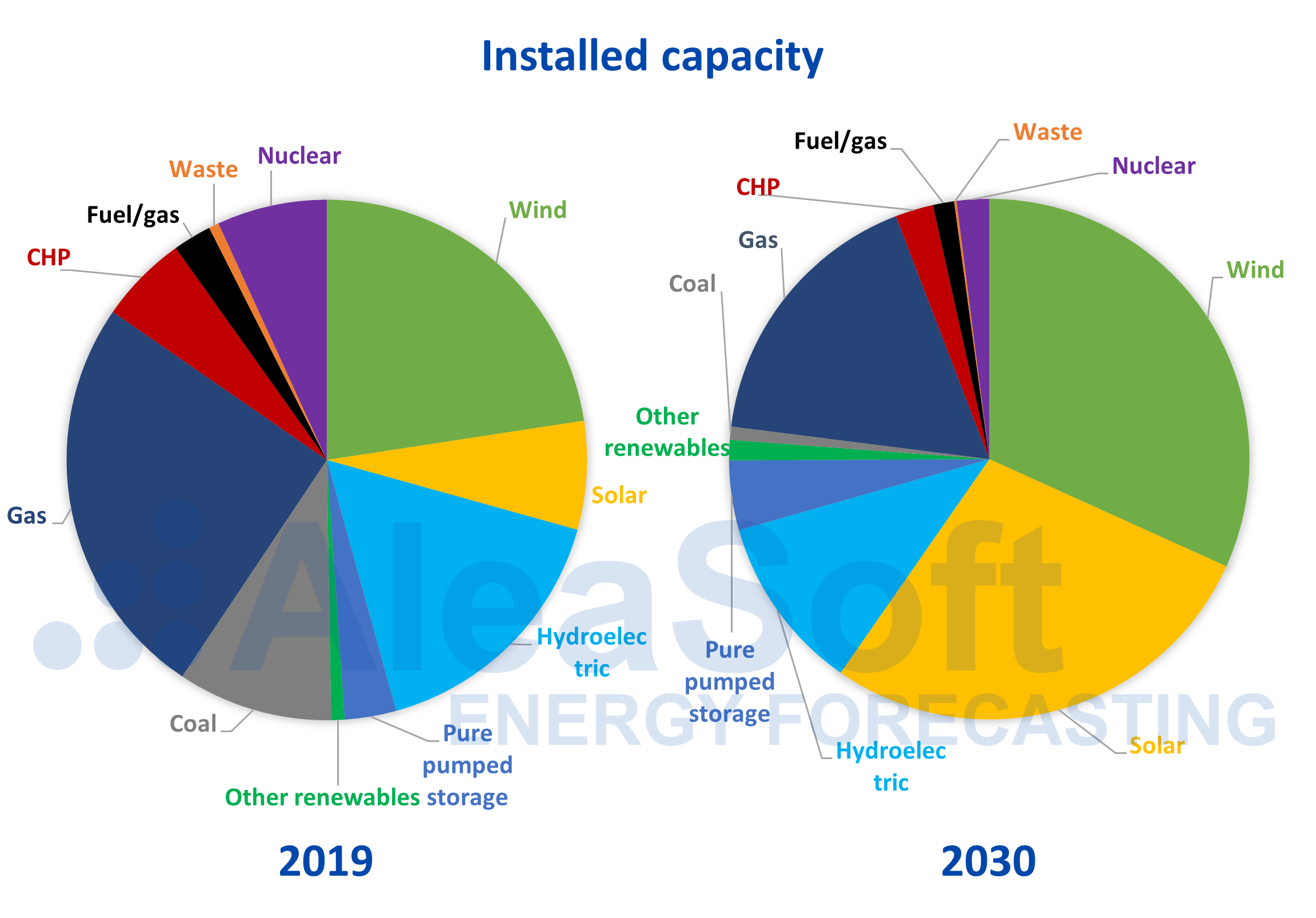Spain’s Integrated National Energy and Climate Plan (NECP) is a broad, cross-cutting document that addresses the goal of reducing greenhouse gas emissions from many angles, from transportation and electricity generation to employment and R&D.
The objective of the plan is to achieve a 20% reduction from 1990 emission levels in 2030. That entails reducing current emission levels by more than 30%. The draft plan lays the foundations to advance the energy transition and achieve an ultimate goal of decarbonizing the Spanish economy and making the country carbon neutral country by 2050.
Electricity generation will have a central role in the energy transition as the sector has heavy CO2 and other greenhouse gas emissions but also offers low carbon alternatives through renewables generation.
The objective of the plan is to achieve, in 2030, renewables penetration of at least 35%. Specifically for electricity, the objective is to source at least 70% of electricity from renewables by 2030, with a final goal of 100% by 2050. To do that, the NECP proposes 69 GW of renewable generation capacity before 2030 and the removal of 15 GW of conventional generation capacity.
Source: Prepared by AleaSoft using data from REE and the Ministry for the Ecological Transition.
The star technology in the renewable revolution will be solar energy, with 37 GW of new capacity – 32 GW of PV and 5 GW of solar thermal. That represents an increase of 530% on Spain’s current solar generation capacity. As previously reported by AleaSoft, PV is considered the most appropriate technology to lead the energy transition due to the abundant solar resource in the Iberian peninsula, especially in the south.
The second technology to be installed before 2030 is wind energy, with 27 GW of new capacity for growth of 114%. Other renewables are expected to add a further 5 GW of capacity.
Among conventional generation assets, Spain is expected to retire at least 8.7 GW of its current 10 GW of coal capacity by 2030, with the possibility of removing it all if security of supply can be assured.
The NECP anticipates coal thermal power stations will no longer be competitive by 2030 if the price of CO2 emission rights reaches €35/t. Right now, the price of emissions is around €23 after tripling last year.
Spain is expected to halve its nuclear capacity to 4 GW by 2030, according to the NECP. Co-generation, energy from waste and fuel-gas are slated for smaller capacity reductions.
The readiness of the NECP to controversially withdraw up to 2 GW of cogeneration is somewhat surprising as the technology is one of the most efficient ways to produce heat. Producing the equivalent thermal energy directly using electricity would involve a disproportionate expense for industry. AleaSoft says the best strategy to reduce emissions in industries that require heat is cogeneration with renewable gas or hydrogen which, according to the consultancy, is the fuel of the future and does not produce significant emissions.
Source: Prepared by AleaSoft using data from REE and the Ministry for the Ecological Transition.
As highlighted by AleaSoft, the renewable transition proposal of the NECP explicitly states the need for a back-up technology to intermittent renewables: to remove 15 GW of conventional capacity it is necessary to install 69 GW of renewable capacity. The draft NECP is committed to gas as a back-up technology, maintaining installed capacity until at least 2030. But storage and interconnections can also support renewables.
In terms of energy storage, the NECP will promote 3.5 GW of new pumped storage hydropower capacity, to enable the management of renewable production and, additionally, support the regulation of watersheds in extreme conditions. The installation of up to 2.5 GW of batteries is also contemplated, gradually, as the technology matures.
AleaSoft feels hydrogen is lacking from the NECP draft, as a tool for storing large amounts of energy over long periods of time and thus able to counteract the seasonality of renewables. In the draft, hydrogen is mentioned only as an alternative fuel for transportation.
On interconnections, the NECP considers planned projects to increase interconnections with France up to 8 GW and with Portugal up to 3 GW. Even with those increases in exchange capacity, though, Spain will not achieve 10% interconnection with respect to its total installed capacity, and will fall far short of the minimum target of 15% set by the European Union.
The draft NECP also takes into account a rise in energy efficiency measures as an essential tool for the energy transition. The Spanish economy has already made advances in energy efficiency since the financial crisis, as AleaSoft has reported.
Other important aspects that the draft NECP takes into account include self-consumption and, in general, a more active role for the consumer. With the approval of the NECP, a demand aggregator will be created to boost the participation of demand in ancillary electricity grid services. It is claimed aggregation of demand will enable greater participation of distributed generation and self-consumption in the imbalance and ancillary markets.


